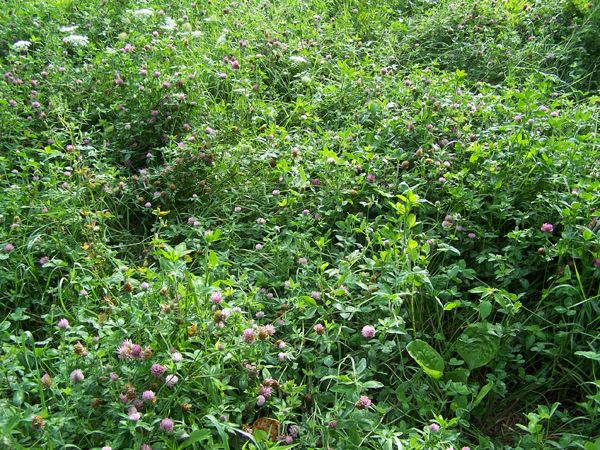
Our available pastures on our farm amount to 5.5 acres. With careful management they supported up to 11 horses. We thought when we got 6 cows it would be enough. Turns out cows eat much more than horses. We leased a neighbor’s 1.5 acre piece, but that wasn’t enough either. So we spoke to another neighbor about a piece of land they had let go. It appeared to be about 10 acres.
These next 2 pictures are what it looked like when we started with it. The goldenrod was so tall my husband had to stand up on his full size tractor to see to mow.
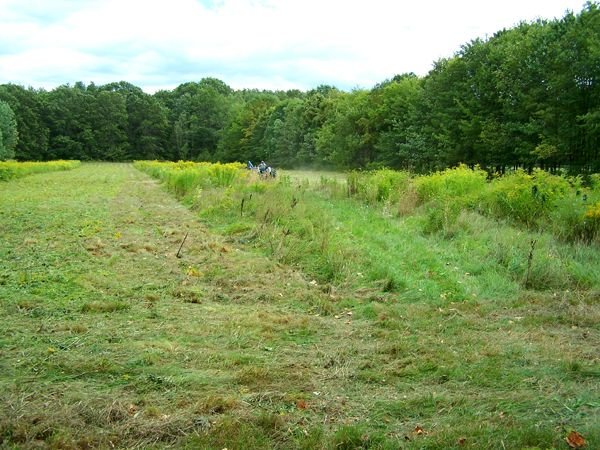
The South side half of the pasture
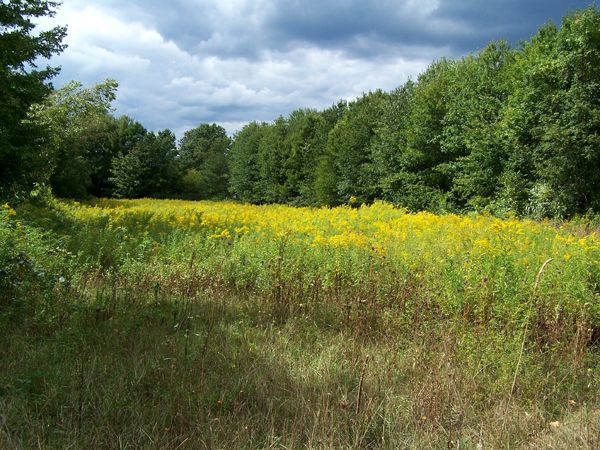
The north side of the pasture

The red is our farm, the white on the far left is the 1.5 acre piece and the white in the center with 2 sections is the 10 acre piece. The attached green on its left is the new 2 acre piece.
We got the pasture in September 2010 and mowed it. There was so little grass we didn’t try to fence it before winter. In 2011 we spent a few months clearing the brush back to the edge of the property and getting a perimeter fence in. Our 6 cows were on it from mid September to mid October. This indicates how little grass there was there, 6 cows were only supported for 1 month on this pasture.
In 2012 we had a series of mishaps with the cows and my husband getting hurt. Our 6 cows grazed this pasture early in the year. In late summer we decided to go into custom grazing with a Devon breeder of 100% grassfed beef and not raise our own any more. We would not have to handle the cows; just move them from pasture to pasture. He sent us 11 yearlings on September 10, 2012. They were on this 10 acre piece until October 8, 2012. This was a big difference from the year before when it only supported ½ as many cows for the same period.
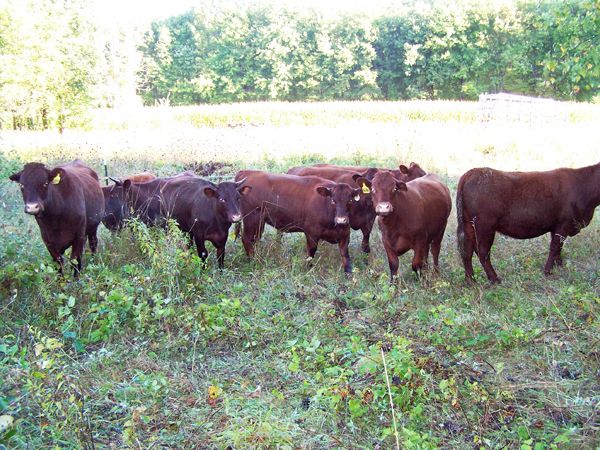
In 2013 the cows arrived on May 16. We got 6 grown cows and a calf. Because the grass was not very high and the quality still not up to par, we move them very quickly over this pasture and they are off it by June 2nd. They return to it in late August and it supports them until mid September. They return to it for the 3rd time in mid October with another grown cow added to the herd making 7 and a calf and are there for 10 days.
So now this piece of land has supported 7 – 8 cows on 3 rotations. The only thing we have done is very careful grazing and the occasional mowing.
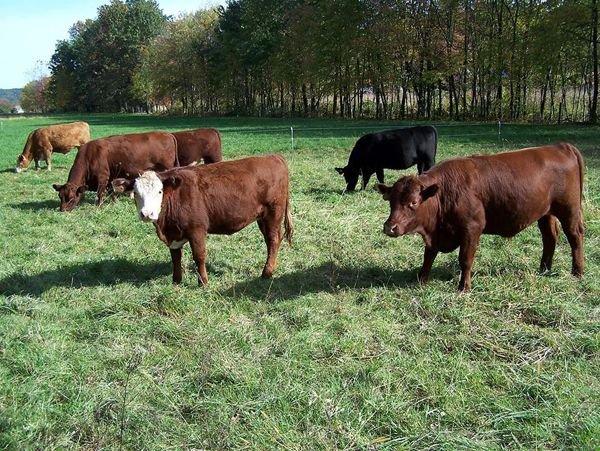
In 2014, the cows arrive on June 5th and there are 7 grown cows and a calf. Being the first grazing, even though pretty grown up due to the late start, we kept it brief and they moved off it in 23 days. At this time one of the cows was unmanageable and was returned to the breeder, so we now had 6 grown cows and a calf.
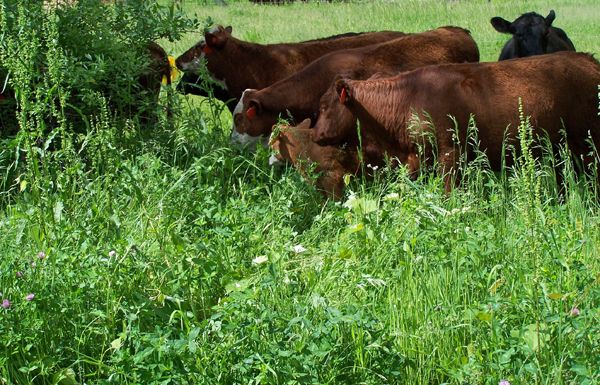
This is the field about 5 weeks since they were on it. The clover is knee high. And to reiterate, the only things we have done to this field since September 2010 are occasional mowing, very carefully managed grazing, long rest periods, and making sure the cows have plenty of minerals. We did not seed, fertilize, lime, or do anything besides the above.
They returned on September 5th and stayed until the first of October. The third run would have been early November for under 10 days. My records are incomplete on this but we dropped our steer on November 24th, and they would have run over the pasture across the street and all of our 5 acres before this.
This was been amazing to us, to have pasture with this many animals this late in the year.
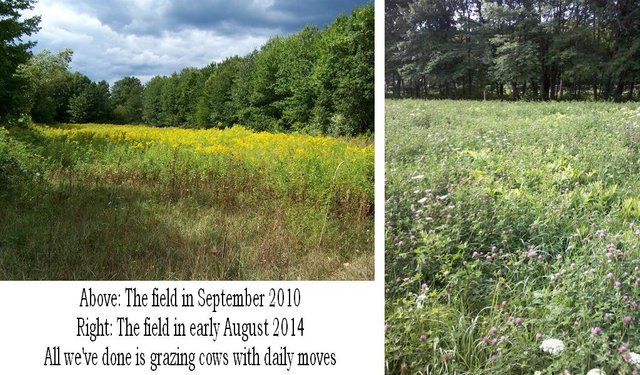
In 2015 they arrived on May 21st but they went onto our pastures first. This herd of 9 yearling heifers had serious trust issues and we did not feel they could make the run to the 10 acre piece until July 20th this year.
They were there only 3 weeks as the grass had gotten too old and tough. They returned September 21 for 12 days and that was it for this year. We lost a whole rotation to behavior problems and our farm was overgrazed, not a good thing.
The grass in September 2015 for the second rotation.
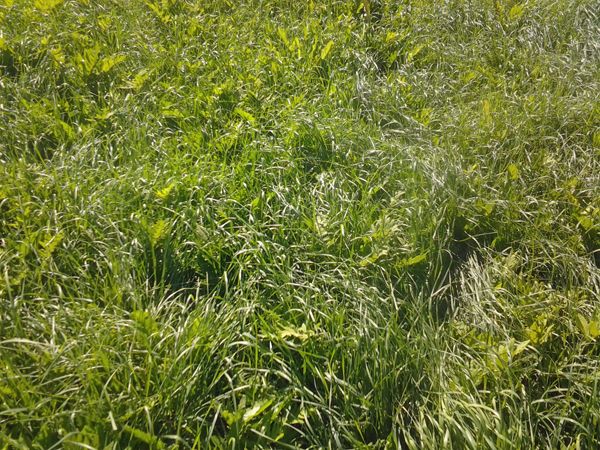
The herd of 8 yearlings returned on June 5, 2016. They again started on our farm and made it to the 10 acre piece on June 24th and stayed until August 25 for 62 days. They returned October 2nd and stayed until October 18th, for 16 days.
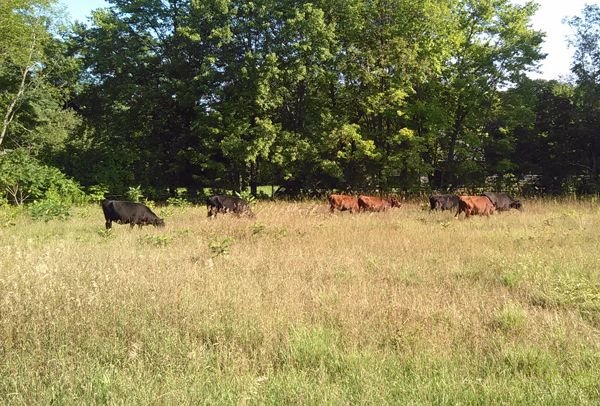
This year was a serious drought year, starting in early spring and running into late winter of the following year. But even so, the 10 acre piece supported the 8 cows for 7 weeks, not including the new section. Including that made it 2 full months.
May 25, 2017 was the arrival day of half the cows. The breeder was using a smaller trailer, and there were to be a lot of calves this year. He didn’t want them crushed. The rest arrived on May 31 and they had all gone right onto the 10 acre piece. May 25: 4 cows, 1 calf, May 31: 3 cows, 2 calves total 7 cows, 3 newborn calves. Another calf was born in June, bringing the total to 11.
This many cows meant much faster moves and shorter rest periods, not a good thing. They moved off June 19th for 25 days for the first round, typically short. Back to the 10 acre July 29 and off August 20th, only 22 days. Back to the 10 acre September 24 and off Oct. 14, for 20 days a longer 3rd rotation than usual.
This is the grass in October 2017, the 3rd rotation with a big herd.
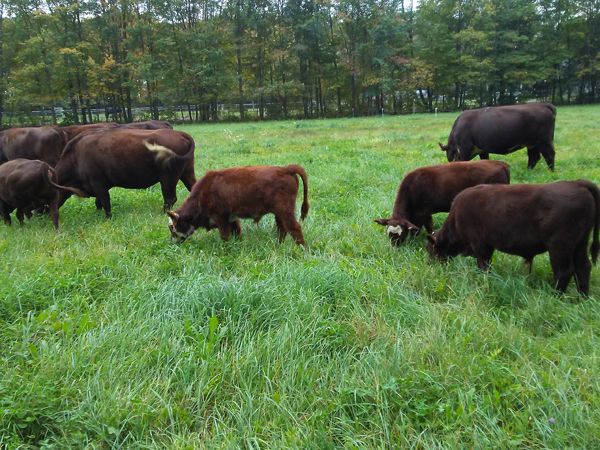
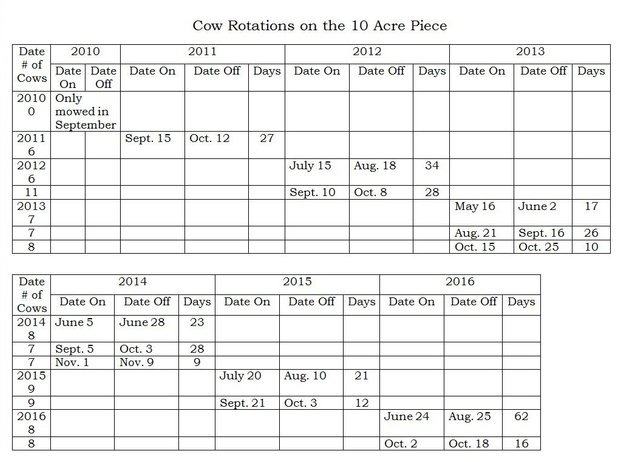
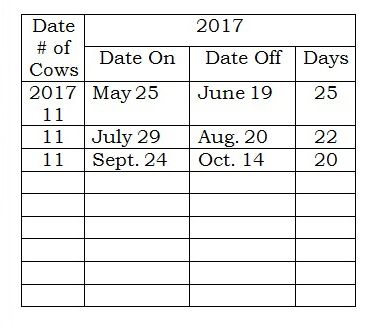
There’s a lot being said about how cows are bad for the environment and atmosphere. If they were properly managed, carefully grazed, given proper minerals, they actually improve the land dramatically.
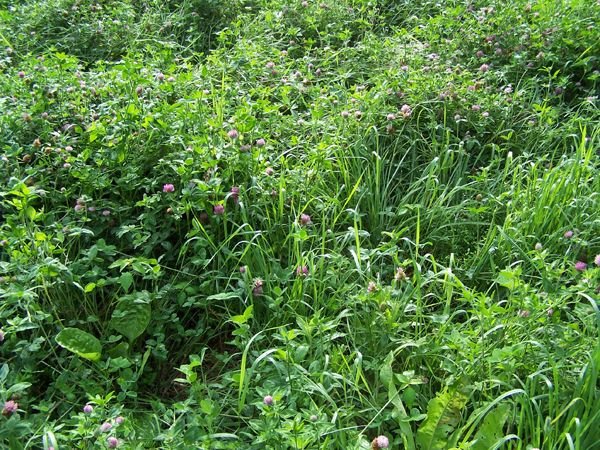
I have referred to the plant matter as “grass” but it is actually far more complex than that. There are multiple species of grass, of forbs, weeds, herbs, and flowers. As Joel Salatin says, a salad bar of plants for them to choose from.
The pulsing from the grazing, but not overgrazing, encourages plant diversity and it puts organic matter back into the soil in 2 ways. The first, when the plant is grazed, the roots die back to the size the plant has been grazed to. These roots become organic matter and add nutrients to the soil.
The second way is the cows trampling into the soil the plants they do not eat. This happens because we keep the paddocks small and encourage them to clean them up without grazing them below 6 – 8”.
The manure gets concentrated and spread evenly. We do not drag the pastures to break up the manure. We leave it in place and let nature break it down. The long rests between grazings means the parasite cycle is broken.
Using this method of managing beef cattle has been very rewarding and interesting. It has become a skill we will continue to hone, working towards having longer pasturage into the winter.
References:
Joel Salatin, author of Salad Bar Beef
Nita of Throwback at Trapper Creek: https://matronofhusbandry.wordpress.com/
Ridge Shinn, https://www.bigpicturebeef.com/

Community Forums
I think what you are doing is perfect. It gets you interacting with your cows more and it really helps the environment.
We also have studies Joel Salatin. We believe in the same ideas. We have goats and work hard to do rotation grazing. We also have our chickens rotation in the same place so they can also provide diversity
Downvoting a post can decrease pending rewards and make it less visible. Common reasons:
Submit
We have broilers we run over our own pastures, but this piece is just too far away for that.
Downvoting a post can decrease pending rewards and make it less visible. Common reasons:
Submit
Well done nice to see other people working with Mother Nature
Thanks for posting
Downvoting a post can decrease pending rewards and make it less visible. Common reasons:
Submit
Wow, excellent breakdown I actually understand how it works now, I have heard about rotating the grazing pastures but I did not realize the extent of benefit to the land or quality of "grass" it produces after a few years for the livestock. That is some lush, beautiful land and some happy cows! <3
Downvoting a post can decrease pending rewards and make it less visible. Common reasons:
Submit
Things are unsustainable when done in an unsustainable way. Like commercial operations. Nothing gets replenished that way. Working with nature is always the best way.
Downvoting a post can decrease pending rewards and make it less visible. Common reasons:
Submit
You have been chosen for this week's steemian embracing by @goldendawne and thanks to @fulltimegeek's delegation as a Steward of Gondor. Please accept this 100% Upvote for this post. You will receive a 100% Upvote for one post every day you make for seven days starting today. CONGRATULATIONS on being a committed steemian!
Downvoting a post can decrease pending rewards and make it less visible. Common reasons:
Submit
Thank you! This was a very hard post to make due to incomplete records. I am glad it's being recognized, after all the work I put into it! I do accept.
Downvoting a post can decrease pending rewards and make it less visible. Common reasons:
Submit